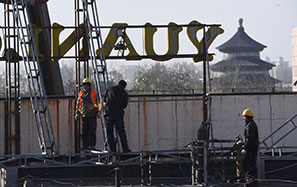Reserve currency status to unleash capital inflows
Recently, the International Monetary Fund's staff and its chief Christine Lagarde suggested that the yuan should join the basket of international reserve currencies (the Special Drawing Rights, or SDR). The inclusion is expected to be approved at the IMF board meeting on Nov 30.
It would make the yuan the first currency of an emerging economy to be included in the basket. And it could unleash three waves of capital inflows into the Chinese currency.
In the first wave, the yuan's inclusion would cause a re-weighting of the SDR basket, which is valued at $280 billion. Currently, it is dominated by the US dollar (42 percent) and the euro (38 percent), followed by the British pound (11 percent), and Japanese yen (9 percent).
The initial weight of the yuan is likely to be about 10-14 percent - as reflected by China's share in global exports (13 percent), foreign exchange reserves (30 percent) and the use of its currency in global capital flows (1-3 percent). That could mean a shift of $40 billion into the yuan's assets starting in October 2016, probably gradually over half a decade.
As long as the deceleration of China's economic growth does not result in a hard landing and financial reforms continue, the IMF endorsement could trigger another wave of larger capital inflows by central banks, reserve managers and sovereign wealth funds.
Today, the allocated part of the global foreign exchange reserves - which the IMF calls the Currency Composition of Official Foreign Exchange Reserves, or COFER - amounts to $6.3 trillion. The US dollar still accounts for nearly two-thirds of the total, against a fourth by the euro, while the pound and the yen are smaller (less than 5 percent each). Assuming that China's current share of global reserves is about 1 percent, the IMF's decision could cause a significant capital inflow (4 percent) into the yuan assets, which would translate to some $350 billion by 2020.
A third capital inflow is likely to ensue as private institutional and individual investors follow in the footprints of the IMF and public investors. If these allocations rise to just 1 percent, they could unleash about $200 billion into the yuan assets by 2020.
In a favorable scenario, the total expected capital inflows to the yuan assets by the IMF, and public and private sector investors could soar to an accumulated $600 billion by 2020.
Moreover, these estimates could prove conservative. China's current share of global reserves may be higher than estimated, as the IMF's total foreign exchange reserves also include $5.7 trillion worth of unallocated reserves.
And after half a decade of stagnation in the major advanced economies, all investors are struggling to gain higher yields and to diversify their assets. So, any major new crisis in the advanced economies could accelerate capital inflows in the yuan assets.
What impact would these shifts have on the yuan's exchange rate? Consensus views expect it to be around 6.35-6.40 to the US dollar by the end of the year but weaken further in 2016 because of the US Federal Reserve's impending rate hikes that will strengthen the dollar.
In the long term, the yuan is likely to strengthen, however.
Today, a gross discrepancy exists between the major international reserve currencies, which are dominated by the advanced economies, and global economic growth prospects, which are increasingly fueled by emerging economies.
When the old Bretton Woods system and the associated dollar hegemony evolved after World War II, US economy dominated half of the world GDP. Today, US economy, which accounts for a fifth of the world economy, suffers from twin deficits, social stagnation and a massive debt burden.
China, which still dominates a third of global growth, has had no role in the IMF basket. Instead, the IMF has been dominated by the four entrenched advanced economies' currencies.
According to McKinsey, substantial purchases of US Treasuries by foreign governments have reduced the US borrowing rate and thus led to annual savings of $90 billion. For emerging economies, that means currency mismatches, which have led to crises in the past. As the Fed starts its hikes, similar calamities are expected once again.
The economic reasons for including the yuan in the IMF basket are compelling, while the risks of not doing so are becoming overwhelming.
The author is research director of international business at the India China and America Institute (US) and a visiting fellow at the Shanghai Institutes for International Studies (China) and the EU Centre (Singapore).


















